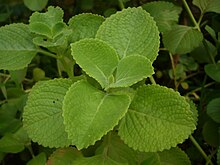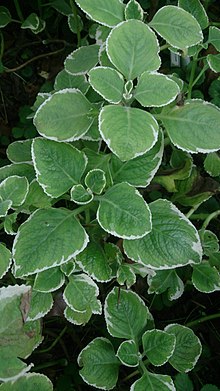| Coleus amboinicus | |
|---|---|

| |
| Scientific classification | |
| Kingdom: | Plantae |
| Clade: | Tracheophytes |
| Clade: | Angiosperms |
| Clade: | Eudicots |
| Clade: | Asterids |
| Order: | Lamiales |
| Family: | Lamiaceae |
| Genus: | Coleus |
| Species: | C. amboinicus |
| Binomial name | |
| Coleus amboinicus Lour. | |
| Synonyms | |
| |
Coleus amboinicus, synonym Plectranthus amboinicus, is a semi-succulent perennial plant in the family Lamiaceae with a pungent oregano-like flavor and odor. Coleus amboinicus is considered to be native to parts of Africa, the Arabian Peninsula, and India, although it is widely cultivated and naturalized elsewhere in the tropics where it is used as a spice and ornamental plant. Common names in English include Indian borage, country borage, French thyme, Indian mint, Mexican mint, Cuban oregano, broad leaf thyme, soup mint, Spanish thyme. The species epithet, amboinicus refers to Ambon Island, in Indonesia, where it was apparently encountered and described by João de Loureiro (1717–1791).
Description
A member of the mint family Lamiaceae, Coleus amboinicus grows up to 1 m (3.3 ft) tall. The stem is fleshy, about 30–90 cm (12–35 in), either with long rigid hairs (hispidly villous) or densely covered with soft, short and erect hairs (tomentose). Old stems are smooth (glabrescent).
Leaves are 5–7 cm (2.0–2.8 in) by 4–6 cm (1.6–2.4 in), fleshy, undivided (simple), broad, egg/oval-shaped with a tapering tip (ovate). The margins are coarsely crenate to dentate-crenate except in the base. They are thickly studded with hairs (pubescent), with the lower surface possessing the most numerous glandular hairs, giving a frosted appearance. The petiole is 2–4.5 cm (0.79–1.77 in). The aroma of the leaves can be described as a pungent combination of the aromas of oregano, thyme, and turpentine. The taste of the leaves is described as being similar to the one of oregano, but with a sharp mint-like flavor.
Flowers are on a short stem (shortly pedicelled), pale purplish, in dense 10-20 (or more) flowered dense whorls (cymes), at distant intervals, in a long slender spike-like raceme. Rachis 10–20 cm (3.9–7.9 in), fleshy and pubescent. The bracts are broadly ovate, 3–4 cm (1.2–1.6 in) long, acute. The calyx is campanulate, 2–4 mm (0.079–0.157 in) long, hirsute and glandular, subequally 5-toothed, upper tooth broadly ovate-oblong, obtuse, abruptly acute, lateral and lower teeth acute. Corolla blue, curved and declinate, 8–12 mm (0.31–0.47 in) long, tube 3–4 mm (0.12–0.16 in) long. Trumpet-like widened; limb 2-lipped, upper lip short, erect, puberulent, lower lip long, concave. Filaments are fused below into a tube around the style.
The seeds (nutlets) are smooth, pale-brown, roundish flattened, c. 0.7 by 0.5 mm (0.028 by 0.020 in).
Distribution and habitat
Coleus amboinicus is native to Southern and Eastern Africa, (from South Africa (KwaZulu-Natal) and Eswatini to Angola and Mozambique and north to Kenya and Tanzania) the Arabian Peninsula and India, where it grows in woodland or coastal bush, on rocky slopes and loamy or sandy flats at low elevations. The plant was later brought to Europe, and then from Spain to the Americas, hence the name Spanish thyme.
Research
In basic research, the effects of the essential oil were tested with other plant essential oils for possible use as a mosquito repellant.
Uses
The leaves are strongly flavored. The herb is used as a substitute for oregano to mask the strong odors and flavors of fish, mutton, and goat. It may be batter-fried to make pakodas or rasam. In the Caribbean, leaves are commonly used when seasoning meats for its pungent aroma.
Fresh leaves are used to scent laundry and hair. It is also grown as an ornamental plant.

Phytochemicals
The main chemical compounds found in the essential oil of Coleus amboinicus are carvacrol (28.65%), thymol (21.66%), α-humulene (9.67%), undecanal (8.29%), γ-terpinene (7.76%), p-cymene (6.46%), caryophyllene oxide (5.85%), α-terpineol (3.28%), and β-selinene (2.01%). Another analysis obtained thymol (41.3%), carvacrol (13.25%), 1,8-cineole (5.45%), eugenol (4.40%), caryophyllene (4.20%), terpinolene (3.75%), α-pinene (3.20%), β-pinene (2.50%), methyl eugenol (2.10%), and β-phellandrene (1.90%). The variations can be attributed to the methodology used in the extraction process, seasonal variations, soil type, climate, genetic and geographical variations of the plant.
Cultivation
Coleus amboinicus is a fast-growing plant commonly grown in gardens and indoors in pots. Propagation is by stem cuttings, but it can also be grown from seeds. In dry climates the herb grows easily in a well-drained, semi-shaded position. It is frost tender (USDA hardiness zones 10–11) and grows well in subtropical and tropical locations, but will do well in cooler climates if grown in a pot and brought indoors, or moved to a warm, sheltered position in winter. In Hawaii and other humid tropical locations, the plant requires full sun. It can be harvested throughout the growing season to be used fresh, dried, or frozen.
Common names
- Big thyme in Grenada, West Indies
- Cuban oregano
- Country borage
- French thyme
- Indian borage
- Mexican mint (US, favored common name)
- Oregano brujo (witch oregano) in Puerto Rico
- Orégano francés (in Cuba and other Spanish language sources)
- Pudina (in Trinidad and Tobago, Guyana and Suriname by the Indian population)
- Soup mint
- Spanish thyme
- Thick leaf thyme or broad leaf thyme
- Vattelao (in Goa, former Portuguese colony in India)
Gallery
See also
- Hedeoma patens, Spanish common name orégano chiquito ('small oregano')
- Lippia graveolens, Mexican oregano or orégano cimarrón ('wild oregano')
References
- ^ Paton, Alan J.; Mwanyambo, Montfort; Govaerts, Rafaël H.A.; Smitha, Kokkaraniyil; Suddee, Somran; Phillipson, Peter B.; Wilson, Trevor C.; Forster, Paul I. & Culham, Alastair (2019). "Nomenclatural changes in Coleus and Plectranthus (Lamiaceae): a tale of more than two genera". PhytoKeys (129): 1–158. doi:10.3897/phytokeys.129.34988. PMC 6717120. PMID 31523157.
- ^ "Plectranthus amboinicus (Indian borage), Datasheet, Invasive Species Compendium". Centre for Agriculture and Biosciences International. 23 November 2017. Retrieved 13 March 2020.
- "Coleus amboinicus Lour.". Plants of the World Online. Royal Botanic Gardens, Kew. Retrieved 2021-08-30.
- https://www.smgrowers.com/products/plants/plantdisplay.asp?cat_id=14&plant_id=3810&page=9, accessed 23 May 2020
- ^ Culinary herbs, by Ernest Small, National Research Council of Canada NRC Research Press, 1997, p. 488.
- Florida's Best Herbs and Spices: Native and Exotic Plants Grown for Scent and Flavor, by Charles R. Boning, Pineapple Press Inc, 2010 p. 75.
- Flora Malesiana, Vol. 8, by Steenis, C. G. G. J. van (Cornelis Gijsbert Gerrit Jan); Steenis-Kruseman, M. J. van; Indonesia. Department Pertanian; Lembaga Ilmu Pengetahuan Indonesia; Kebun Raya Indonesia, Publication date 1950, p. 387. Available on https://archive.org/details/floramalesiana83stee.
- ^ Codd, L. E. W. et al. Flora of Southern Africa : the Republic of South Africa, Basutoland, Swaziland and South West Africa. Vol. 28, part 4, 1981, page 148. Available on Biodiversity Heritage Library at https://www.biodiversitylibrary.org/page/51375271.
- Flora Malesiana, Vol. 8, by Steenis, C. G. G. J. van (Cornelis Gijsbert Gerrit Jan); Steenis-Kruseman, M. J. van; Indonesia. Departemen Pertanian; Lembaga Ilmu Pengetahuan Indonesia; Kebun Raya Indonesia, Publication date 1950, p. 387. Available on https://archive.org/details/floramalesiana83stee.
- ^ "Plectranthus amboinicus". Germplasm Resources Information Network. Agricultural Research Service, United States Department of Agriculture. Retrieved 21 August 2012.
- George Staples; Michael S. Kristiansen (1999). Ethnic Culinary Herbs: A Guide to Identification and Cultivation in Hawaii. University of Hawaii Press. p. 88. ISBN 978-0-8248-2094-7.
- Lalthazuali; Mathew, N (2017). "Mosquito repellent activity of volatile oils from selected aromatic plants". Parasitology Research. 116 (2): 821–825. doi:10.1007/s00436-016-5351-4. PMID 28013374. S2CID 5158038.
- The Herbalist in the Kitchen, by Gary Allen, University of Illinois Press, 2010, p. 198
- Senthilkumar, A; Venkatesalu, V (2010). "Chemical composition and larvicidal activity of the essential oil of Plectranthus amboinicus (Lour.) Spreng against Anopheles stephensi: A malarial vector mosquito". Parasitology Research. 107 (5): 1275–8. doi:10.1007/s00436-010-1996-6. PMID 20668876. S2CID 6776822.
- Lopes, P. Q; Carneiro, F. B; De Sousa, A. L; Santos, S. G; Oliveira, E. E; Soares, L. A (2017). "Technological Evaluation of Emulsions Containing the Volatile Oil from Leaves of Plectranthus Amboinicus Lour". Pharmacognosy Magazine. 13 (49): 159–167. doi:10.4103/0973-1296.197646 (inactive 1 November 2024). PMC 5307902. PMID 28216901.
{{cite journal}}: CS1 maint: DOI inactive as of November 2024 (link) - "Plectranthus amboinicus". Fine Gardening. Retrieved 2017-07-18.
- "Cuban Oregano (Plectranthus amboinicus) | My Garden Life". www.mygardenlife.com. Retrieved 2022-02-08.
- Gary Allen, The Herbalist in the Kitchen, University of Illinois Press, 2010, p. 198.
- ^ Tropicos, http://www.tropicos.org/Name/17602719, accessed 21 August 2012
- Encyclopedia of Life, https://eol.org/pages/50437093/names, accessed 23 May 2024
- and (both in Spanish)
- "Coleus amboinicus | PlantZAfrica". pza.sanbi.org.
| Taxon identifiers | |
|---|---|
| Coleus amboinicus |
|
| Plectranthus amboinicus |
|




